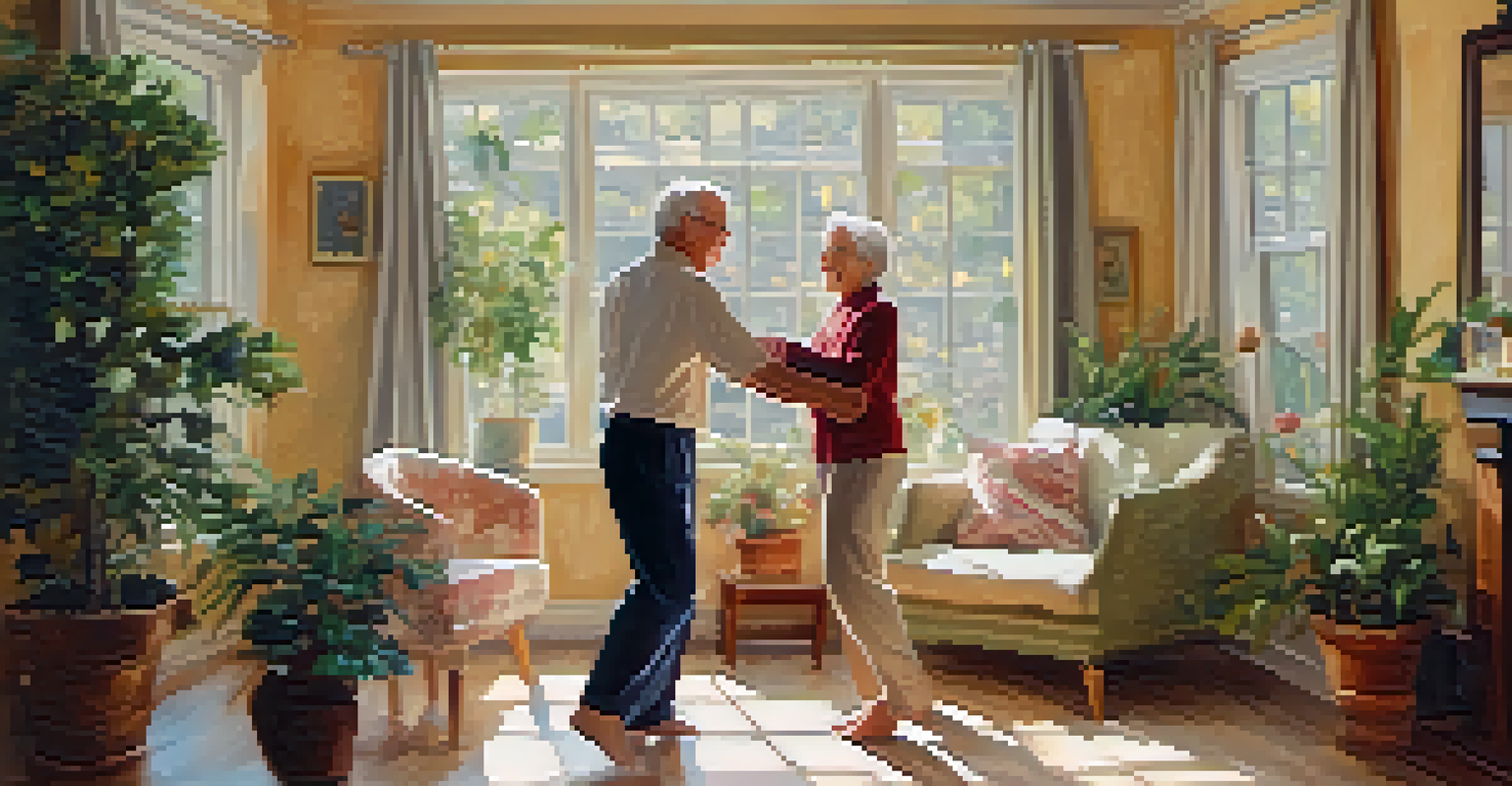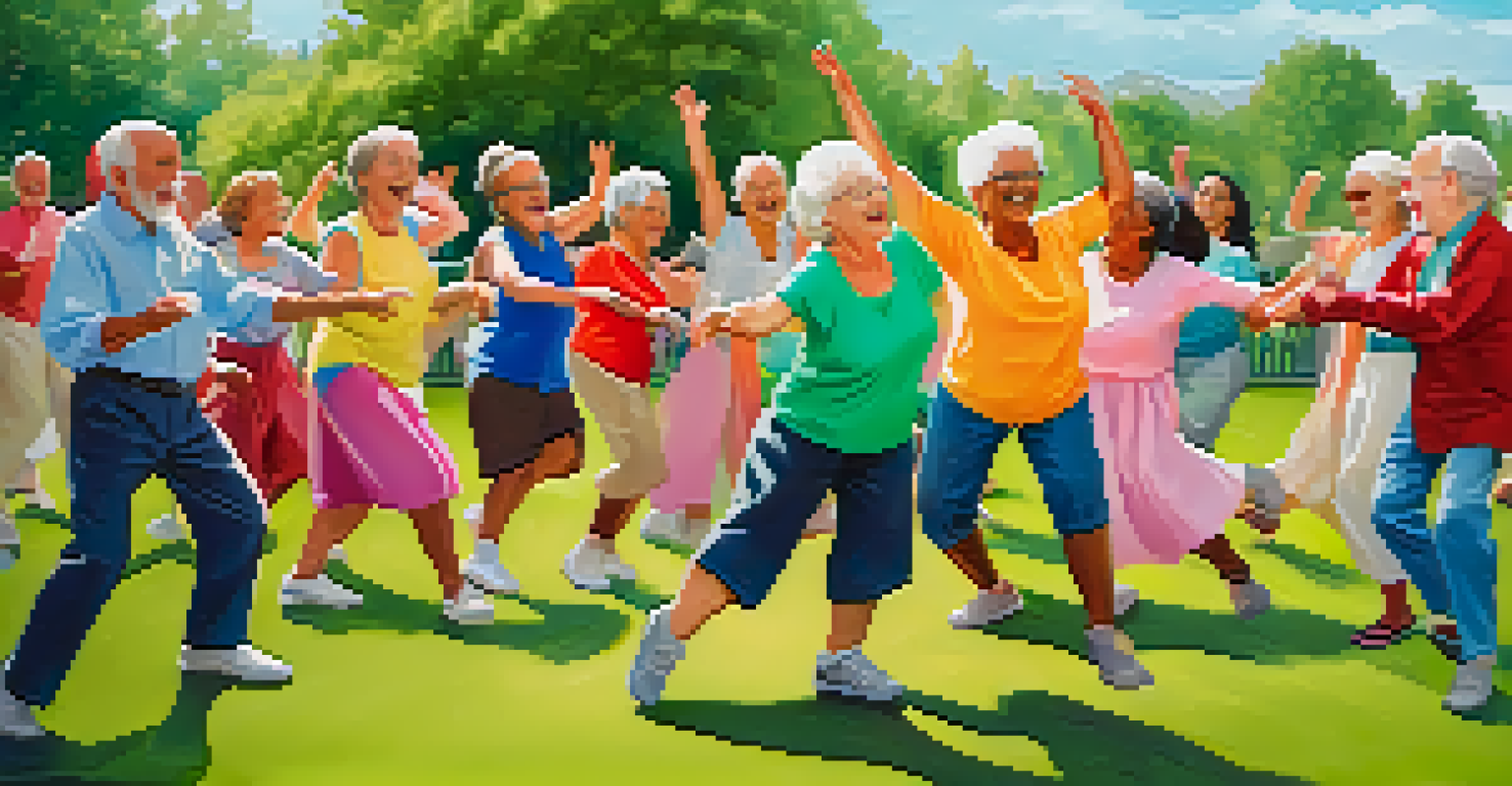Dance Therapy: A Creative Outlet for Senior Citizens

Understanding Dance Therapy and Its Benefits for Seniors
Dance therapy is a form of expressive therapy that uses movement to promote emotional, cognitive, and social integration. For senior citizens, it offers a unique way to connect with their bodies and express feelings that may be hard to articulate in words. This creative outlet helps reduce feelings of isolation and boosts overall mental health, making it a wonderful tool for enhancing well-being.
Dance is the hidden language of the soul.
Engaging in dance therapy can improve physical health, too. The gentle movements involved in dance help increase flexibility, strength, and coordination, which are crucial for seniors to maintain their independence. Moreover, the rhythmic movements stimulate the brain, keeping it active and engaged, which is essential for cognitive health.
Finally, dance therapy fosters social connections. Group classes create a sense of community, allowing seniors to meet new people and build friendships through shared experiences. This nurturing environment creates a support system that can significantly enhance their quality of life.
The Emotional Benefits of Dance Therapy for Seniors
One of the most significant emotional benefits of dance therapy is its ability to help seniors express feelings and release pent-up emotions. Many seniors may struggle with grief, loneliness, or anxiety, and dance provides a safe and creative outlet for these emotions. Through movement, they can channel their feelings in a non-verbal way, leading to emotional relief and healing.

Additionally, dance therapy encourages self-esteem and body positivity. As seniors engage in movement, they often discover new ways to appreciate their bodies and capabilities, which can shift their perspective on aging. This newfound confidence can profoundly impact their daily lives, inspiring them to take on new challenges.
Dance Therapy Boosts Emotional Health
Dance therapy provides seniors with a creative outlet to express feelings and combat loneliness, fostering emotional relief and healing.
Lastly, dance therapy is a joyful experience that brings playfulness back into seniors' lives. The act of dancing can evoke memories of happier times and foster a sense of nostalgia, creating a bridge between the past and present. This joy can be contagious, encouraging seniors to approach life with a more positive outlook.
How Dance Therapy Can Combat Loneliness in Seniors
Loneliness is a common challenge faced by many seniors, especially those who may have lost loved ones or are living alone. Dance therapy offers an engaging way for seniors to connect with others while participating in a joyful activity. The group dynamic creates an instant sense of belonging, reducing feelings of isolation and abandonment.
The only way to make sense out of change is to plunge into it, move with it, and join the dance.
Moreover, dance therapy sessions often involve partner work or group dances, which further strengthens social bonds. These interactions encourage communication and collaboration, allowing seniors to build relationships and support networks. This sense of community can be vital for emotional health and well-being.
By participating in dance therapy, seniors also have the chance to share their stories and experiences through movement. This shared expression fosters empathy and understanding among participants, deepening their connections. Ultimately, dance therapy not only combats loneliness but also enriches the lives of seniors by building lasting friendships.
Choosing the Right Dance Therapy Program for Seniors
When selecting a dance therapy program, it's important to consider the individual needs and preferences of seniors. Some may prefer low-impact styles like ballroom dancing or gentle yoga, while others might lean towards more energetic forms like jazz or contemporary dance. Finding the right fit ensures that participants feel comfortable and engaged in the process.
It's also essential to look for qualified dance therapists who have experience working with older adults. A trained professional can tailor sessions to accommodate physical limitations and create a safe environment for exploration. This personalized approach maximizes the benefits of dance therapy and ensures a positive experience.
Physical Benefits for Seniors
Engaging in dance therapy enhances seniors' physical health by improving flexibility, strength, and coordination, which are vital for maintaining independence.
Lastly, consider the social aspect of the program. Many seniors thrive in group settings, so programs that promote interaction and teamwork can be particularly beneficial. Ultimately, choosing the right dance therapy program can lead to a fulfilling and enriching experience for seniors.
The Role of Music in Dance Therapy for Seniors
Music plays a crucial role in dance therapy, acting as a catalyst for movement and emotional expression. The right tunes can evoke memories and feelings, encouraging seniors to connect with their past and enjoy the present moment. This connection to music enhances the therapeutic experience by making it more relatable and enjoyable.
Moreover, different music genres can inspire various types of movement, allowing seniors to explore their creativity. From classical to jazz, the diversity in music can influence the way participants express themselves. This exploration not only keeps the sessions fresh and exciting but also allows seniors to discover new preferences and interests.
Finally, the rhythm and beat of music can help seniors improve their coordination and timing. As they move to the music, they develop a greater sense of body awareness, which can translate to better balance and mobility in their daily lives. The combination of music and movement is a powerful tool for enhancing both physical and emotional well-being.
Success Stories: Seniors Thriving Through Dance Therapy
Many inspiring stories highlight the transformative power of dance therapy for seniors. For example, a group of retired teachers found a new lease on life through a local dance program, bonding over their love for movement and music. Not only did they improve their physical health, but they also formed friendships that enriched their everyday lives.
Another touching story involves a widow who struggled with loneliness after her husband's passing. She joined a dance therapy class and discovered a supportive community that helped her heal and rediscover joy. Through dance, she was able to express her grief while also creating new memories with her peers.
Building Connections Through Movement
Group dance therapy sessions create a sense of community, allowing seniors to forge friendships and support networks that enrich their lives.
These success stories illustrate how dance therapy can empower seniors to embrace life with renewed enthusiasm. The shared experiences and emotional connections fostered in these programs can lead to profound changes in perspective and quality of life.
Conclusion: Embracing Dance Therapy for a Vibrant Senior Life
Dance therapy offers a unique and joyful approach to enhancing the lives of senior citizens. By combining movement, music, and social interaction, it addresses both physical and emotional needs, making it a holistic form of therapy. The benefits of dance therapy extend far beyond the dance floor, promoting overall well-being and happiness.
Encouraging seniors to explore dance therapy can open doors to new experiences and friendships. It not only provides a creative outlet for self-expression but also fosters a sense of community that is essential for mental health. This vibrant form of therapy can help seniors navigate the challenges of aging with grace and joy.

Ultimately, embracing dance therapy is about celebrating life and the unique journey of each individual. By incorporating movement into their lives, seniors can find renewed purpose and vitality, proving that it’s never too late to dance your way to a happier, healthier life.